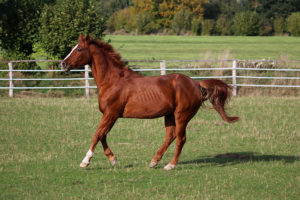Study: Shoe Types and Combinations Modify Neck and Back Movement

Researchers recently demonstrated that shoeing options can change the way a horse moves his back and neck, with potential consequences on his performance, health, and welfare.
Sébastien Caure, DVM, IPSAV, Dipl. ECVS, a veterinarian at the Livet Equine Veterinary Hospital Center, in Livarot-Pays-d’Auge, France; Renée Weller, PhD, of the University of Calgary, in Canada; and their colleagues placed reflective markers along the back and neck of six mixed-breed, sound, and barefoot riding horses who received regular trims. All the horses had been at rest at pasture for at least a year. The researchers filmed the horses walking and trotting in a straight line across a freshly dragged outdoor sand arena with seven types of hoof treatments each:
- Bare front and hind feet
- Bare front feet/shoes on hind feet
- Shoes on front feet/bare hind feet
- Shoes on front feet/shoes on hind feet
- Shoes on front feet/egg bar shoes on hind feet
- Shoes on front feet/wide-toe shoes on hind feet
- Shoes on front feet/reverse shoes on hind feet.
All shoes were composed of a lightweight metal (aluminum or steel) and weighed between 180 and 260 grams (6 to 9 ounces)—about half the weight of traditional steel shoes—to reflect real-life conditions in both equitation and racing. The horses rested in a stall for at least two hours between each treatment.
Shoeing’s Affect on Equine Neck and Back Flexion
Using computer analyses of the markers on the video footage, the team calculated joint angles along the spine from the poll to the lumbosacral area.
Compared to shod horses, they found barefoot horses displayed lower neck carriage with increased flexion along the lower neck and withers and a more horizontal thoracolumbar area (less flexion of the spine under the area at the back of the saddle), Caure said. The equine back has a limited range of motion from the saddle area to the tail, and some horses are naturally more flexible in the back than others. The neck, meanwhile, is highly flexible—which might be why two-thirds of sport horses experience instability and osteoarthritis of the lower neck, Caure said.
Wearing shoes only in the front led specifically to higher neck carriage and greater flexion in the thoracolumbar region at the back of the saddle area. That could be due to naturally greater weight-bearing on the forelimbs compared to hind limbs, or because the great mass of horses’ rumps dampens the effect of shoes, Caure explained. The fact the front feet are simply closer to the neck might also play a role, he added.
“You can really increase the expression of your horse’s head and neck and forelimb movements by shoeing him just in the front,” he said. While that might benefit upper-level dressage scores, it’s probably not ideal long-term due to excessive use of the joints, he added.
Likewise, the three types of orthopedic shoes used in the hind limbs triggered a higher neck carriage in both the walk and trot. That might be because the shoes have 200% of the surface area of standard shoes, the researchers reported.
Wide-toe and reverse shoes increased flexion of the C3 joint (the third cervical vertebra) near the poll. Eggbar and reverse shoes—the two that cover the heel—on the hind limbs led to a flatter thoracic angle and increased dorsal/ventral flexion of the lumbosacral area. Eggbar shoes also increased thoracolumbar flexion as the hind feet touched the ground at a walk.
In addition, Caure said eggbar shoes on the hind feet helped horses push off with their hind limbs more symmetrically, which he said can be therapeutic in rehabilitating horses recovering from hind-limb lameness.
By contrast, having shoes on only the back feet had no significant effects on back and neck joint angles, he said.
Take-Home Message
Barefoot horses displayed a lower neck position than shod horses, and those shod on the front feet only carry their necks higher with greater flexion of the thoracolumbar area at the back of the saddle space. Orthopedic shoes on the hind limbs also led to higher necks and more thoracolumbar flexion. Veterinarians, farriers, coaches, and riders should keep these effects in mind when assessing, treating, and training horses, said Caure. “Lots of people—whether they’re riders, trainers, or surrey jockeys—say that their horses ‘feel’ different when the shoeing format changes,” he said. “Our study shows that they’re right. Shoeing significantly affects the way the upper body moves, a lot more than we ever thought.”
The study, “Effects of different shoeing conditions on equine cervical and back kinematics during walking and trotting on a soft surface,” appeared in the Journal of Equine Veterinary Science in November, 2024.

Related Articles
Stay on top of the most recent Horse Health news with


















